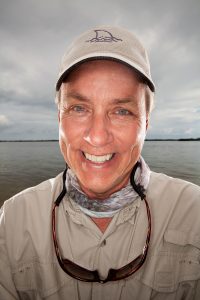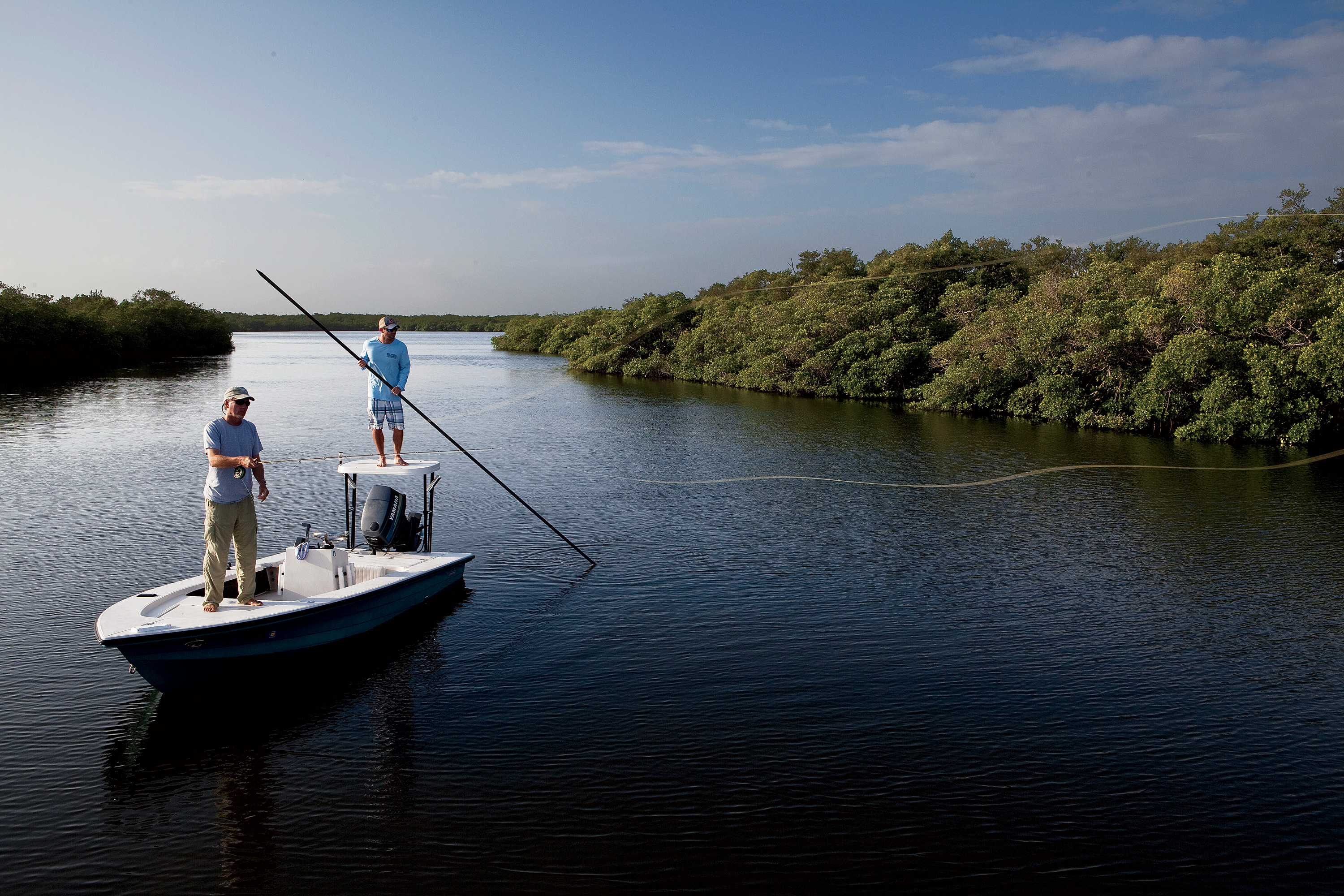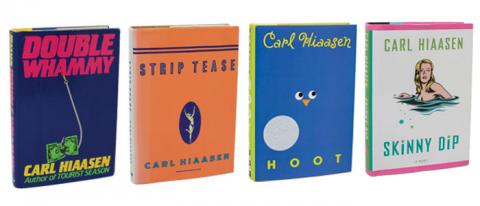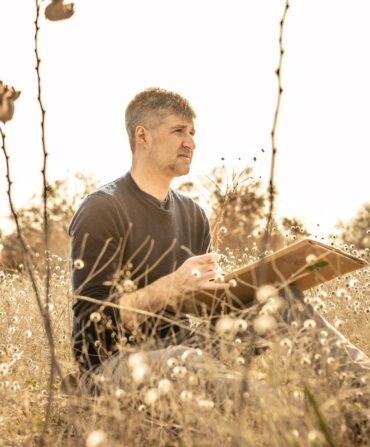Land & Conservation
Carl Hiaasen: The Last Great Howler
Carl Hiaasen has spent a lifetime railing against corrupt politicians and the wanton destruction of Florida’s natural riches. Along the way he’s become one of the country’s most successful novelists, not to mention one hell of a fly fisherman

Photo: Nathaniel Welch
Steve Huff, his weathered right hand on the motor’s tiller, leads us away from the Chokoloskee, Florida, dock in his sixteen-foot Hell’s Bay skiff. As the bow comes down on plane, like a man nodding to sleep in a chair, he nonchalantly starts carving turns through what appears to be an inscrutable, watery maze of mangroves.
I’m seated next to Huff, my head down into the chilly wind. In front of us, in his “lucky seat” in the middle of Huff’s boat, is the writer Carl Hiaasen. He’s wrapped up like an Iditarod musher—ski hat, rain pants, winter jacket,bandanna-like Buff covering his face. At one point, perhaps a bit self-conscious about his getup, Hiaasen turns to me and peels down the Buff. “I’m from South Florida,” he yells over the whine of the motor. He quickly pulls the garment back over his face and turns and looks over the bow at the Everglades, the last true wilderness in this part of the world, a geography that is, to borrow Pat Conroy’s line, Hiaasen’s wound, but also his salve.
There are only a few clouds in the sky, but they are big and cottony and they occasionally blot out the sun. Huff leads us to one of his favorite flats in the backcountry, a spot where acres of gnarled dead mangroves—bleached gray and white by the sun—haunt the horizon, the detritus of 1992’s Hurricane Andrew. “Man, it looks postapocalyptic in here, Steve,” Hiaasen says. A few blaze-pink roseate spoonbills perched in the dead branches provide a Technicolor contrast to the whole scene.
Fish are around, a few singles here and there. Snook and redfish. Hiaasen, still bundled for now, holds a fly rod in the bow, scanning the water. This is a very familiar scene for Hiaasen and Huff, longtime friends and fishing companions. Huff, the sixty-seven-year-old guiding icon, has a static roster of fifteen clients. Hiaasen is one of them. They fish in concert.
“There’s one, Steve,” Hiaasen says. He relaxes his body into a quick and perfect cast, two feet in front of the moving fish’s nose. He strips the fly.
“Good,” says Huff from the back.
“Dammit!” Hiaasen says. The fish, a nice red, has flushed for no discernible reason. “You suck, Carl,” he says to himself, then turns to Huff. “I’m sorry, Steve.”
“That was a great cast, Carl,” says Huff, fishing guide, coach, and shrink.
The fish are particularly spooky this morning, a circumstance that allows Hiaasen to utilize his varied vocabulary. An uncooperative fish is, at different times, a “schmuck,” a “butt-licker,” a “knucklehead,” or a “dickbrain.” Hiaasen is an intense angler. He has chipped four teeth while biting tippet. On the bow, even as he talks on a wide range of subjects—shady Miami mayors, stalkers on book tours, the current sad state of bonefishing in the Keys—he is always watching the water, always on point.
That intensity has put him in the top 1 percent of flats fly anglers. A few years ago he caught a 140-pound tarpon with Huff here in the Everglades. In 2004, he landed a 14-pound, 8-ounce bonefish in the Keys with guide Tim Klein, just a can of beer away from the fly fishing world record. On April 1, 1998, while fishing with Huff, he landed a 43-pound permit, which would have been the fly record had the tip of his rod not snapped off—which disqualified it—just as the fish was about to be tailed.
 Hiaasen recently turned sixty but still has that cherubic face and those see-right-through-you cerulean eyes. Only his graying hair betrays his age.
Hiaasen recently turned sixty but still has that cherubic face and those see-right-through-you cerulean eyes. Only his graying hair betrays his age.
He is the author of twenty-three books—novels, young adult titles, and nonfiction screeds—and writes a weekly column for the Miami Herald, where he started as a reporter at the age of twenty-three. He has sold more than twelve million books in the United States. All of his novels since 1993’s Strip Tease have been best sellers. He won the coveted Newberry Honor for his 2002 children’s book, Hoot.
Hiaasen’s novels are not dense literary tomes. They are fun, fast reads filled with hilarious one-liners and biting satire (the Los Angeles Times once called him the heir to Mark Twain). But what’s most emphatic in the writings of Hiaasen is the outrage—over our rampant moral and political corruption and senseless destruction of the environment, mostly in his beloved home state of Florida, the setting for nearly everything he writes.
This outrage, though veiled in the humor and fun, is not heedless. It is comforting, even emboldening, to read his work and realize that we are not alone, that it is perfectly okay to be mad and exasperated about these dark forces that seem to have left us defenseless. Hiaasen gives us a voice, and for this reason he is one of the most important writers of the last half century. He is our howler, Southern in focus but American—even global—in reach.

Photo: Nathaniel Welch
Word Shark
Hiaasen, who likes to write while wearing a pair of earmuffs, at his desk in Vero Beach, Florida.
His latest adult novel, Bad Monkey, will be released in June. It’s set in the lower Keys and in the Bahamian island of Andros, two places, not coincidentally, where Hiaasen spends a lot of time fishing (he now lives in Vero Beach but has a house in the Keys). The bad guy is a Medicare fraudster, drawn from a depressingly large number of real-life examples. The hero is the archetypal Hiaasen lead, a flawed but highly decent character out to right wrongs—a Monroe County detective who has been demoted to the position of Keys restaurant inspector (known as Roach Patrol) because “he did something terrible to his girlfriend’s abusive husband with a vacuum cleaner,” Hiaasen says. The hero sets out to nab the fraudster, and we vicariously enjoy the ride.
It’s my turn in the bow. Hiaasen remains standing in the middle of the boat, helpfully providing another set of eyes on the water while describing an interaction he had with a copy editor at his publishing house, Alfred A. Knopf. Copy editors, he says, tend to be very literal-minded individuals. This particular one flagged a scene in the Bad Monkey manuscript in which it appeared that the hero and a lady friend had achieved simultaneous orgasms. In the margin, the copy editor wrote a note, questioning whether the scene was realistic.
Hiaasen sent the manuscript back with his own note penned underneath: “Yes, miracles do happen.”
Fishing was Hiaasen’s initial gateway into the natural world. He and his two best friends—Bob Branham and the late Clyde Ingalls—first used dough balls to catch little bluegills, which they called “shellcrackers,” in canals near Plantation, where Hiaasen grew up the son of a lawyer and a stay-at-home mom who was a former English teacher (his father died of complications from esophageal cancer at age fifty). Hiaasen and his fishing pals eventually started doing what all those who are hooked do: They sought bigger fish, dragging an old aluminum boat all over the canals of west Broward County to catch baby tarpon.
But just a few years after high school, when Hiaasen was in college (he split his four years between Emory University and the University of Florida), he came home to find that the swamps, scrub brush, and dirt roads of his childhood were no longer there. And those canals, once teeming with life, had become fet-id, barren drainage ditches. “There were high-rises,” he says. “It just happened so damn fast. And once that concrete is poured, it’s just gone for good.”
Perhaps his most enduring book character was born from that experience. Skink, one of the few Hiaasen creations to appear in more than one of his novels (Double Whammy, Stormy Weather, and four others), is an ex-governor of Florida who tried, and failed, to fight the good fight while in office. Frustrated, he walked away one day, unannounced, to live an environmentally righteous, if somewhat unhinged, life as the unofficial protector of the Everglades, subsisting off the land and, of course, roadkill. Hiaasen’s friend Ingalls, a misfit and staunch defender of nature who killed himself at age seventeen, was partly the inspiration for Skink. “The other part of Skink is me,” Hiaasen says. “He does things I wish I could do.”
Writing started early, too. He wrote recaps of neighborhood kickball games as a child. In school, he says, he was shy, a recluse. “I skipped a grade, so I was always the smallest kid in my class.” He channeled that shyness into a cheeky school newsletter. “All of those big jocks I was scared of, the guys who’d been in school so long they were going bald, liked what I wrote, liked it when I made fun of the teachers and principal,” Hiaasen says. “My father always said I was a smart-ass as a kid. It got me into trouble. But I learned there was a certain profitability in it.” A first job at Cocoa Today (now Florida Today) turned into a gig at the Herald, which turned into three books cowritten with a colleague and, eventually, his enduring career as a novelist.
But as I learned over two days on the water with him, Hiaasen does not play into the popular stereotypes we have of writers and their lives. He doesn’t really drink, maybe occasionally sipping a beer or two. Rather than going out, he prefers to stay in at night with his wife, Fenia, and his thirteen-year-old son, Quinn. Book tours are done only out of a sense of duty to Knopf. “They drain me,” he says. “I do a signing, then stumble into my hotel room and pass out, exhausted.” He doesn’t drink coffee. And though he is buddies with Jim Harrison and Thomas McGuane, he doesn’t even really read all that much. “I wish I did,” he says. “I really should. But I’m just so drained by a day of writing.” Even when things are flowing, he says, “I’ll walk from my office into the kitchen and Fenia will tell me I look like I just came from a funeral.”
Writing, despite the toll it exacts, is his high. “I really don’t know what I would do without it,” he says. It’s one reason he stays so prolific, with a book every eighteen months or so, alternating now between books for kids and adults. His expression of moral outrage through his characters—Skink and his passion for protecting the Everglades; Shad, the bouncer in Strip Tease, and his pure-hearted devotion to the dancers under his protection; Nature Girl’s Honey Santana and her disgust with telemarketers selling cheap land—is, he says, “my therapy.”
And fishing, particularly on the beguiling flats, is how he recharges. His best friends are all fishermen, he says, but he often fishes alone. “It’s a great reminder of what I do this for.”

Photo: Nathaniel Welch
Hiaasen works a stretch of mangroves with his fly rod.
As dusk begins to settle on our first day, we head back in. Despite the tough weather and snotty fish, we’d managed to catch a decent number of snook and some good-size redfish. We pull into the dock, owned by Ted Juracsik, the maker of perhaps the best saltwater fly reels on earth. Juracsik, a slight and white-haired septuagenarian Hungarian immigrant, is there to greet us. He’d been out all day catching grouper. He says hello to Huff and Hiaasen, and asks how the latter’s writing is going. “Good, Ted, good,” Hiaasen replies. “Thanks for asking.”
Juracsik stops for a beat, rocking back on his feet. His craggy old-world face looks up into Hiaasen’s. “You know, I always wondered this,” he says. “How in the hell do you come up with the names of them characters in your books?”
Hiaasen just laughs, shyly.
The next morning we head to the mouth of the Lost Man’s River, forever memorialized in Peter Matthiessen’s Watson trilogy. The plan for the day is to work the flats near the mouth of the river for snook and redfish until the sun warms the water a bit. Then we’ll hunt for tarpon.
I ask Hiaasen about his family. His older son, Scott, has followed in his footsteps as an award-winning investigative reporter at the Herald (he will graduate from law school this year). Hiaasen married Scott’s mother, his high school sweetheart, at age seventeen. They were divorced twenty-six years later. “We just grew into different people,” Hiaasen says. After the divorce, he moved to the Keys and met Fenia and married her. Hiaasen became the stepfather of Fenia’s son, Ryan, and they had Quinn a year after they were married. Quinn is a crackerjack tennis player who plays “up” an age division in the hypercompetitive Florida youth tennis scene. His serving coach is Roscoe Tanner. Hiaasen expresses some ambivalence about Quinn’s tennis, worrying when he sees the young boy tense up because of the game. “I just want him to be happy,” he says.
At some point in the morning, there is a brief discussion about the burgeoning new world of social media, about its merits and demerits. “I don’t know much about it, really,” Hiaasen says. “I’m not on Twitter or Facebook.”
“I’m so disconnected,” says Huff, who does not even have an e-mail address.
“Do you have people who come on the boat and use their smartphones?” Hiaasen asks.
“Not for long,” Huff says.
Huff then decides it’s time to look for tarpon. Hiaasen is in the bow with the 12-weight, a big purple fly dangling from his hand. The conditions still aren’t quite right: It’s a bit chilly, and the sky is crowded with passing clouds, making the black water nearly impenetrable. But we’re going to give it a try. A few tarpon have rolled in a likely spot in the distance.
But when we get there, we see nothing. After a half hour, Hiaasen abdicates his spot in the bow and sits down to eat his lunch. I stare into the water, fruitlessly. Suddenly, there’s a huge swirl on the starboard side of the boat. We’ve come right up on a laid-up tarpon and spooked it. “How’d you miss that one?” Hiaasen says to me, his smile curling around a mouthful of turkey sandwich.
“Man, we’re going to need a horseshoe to fall out of our ass to get one today,” Huff says.
The horseshoe stays put.
It’s no matter, though. Huff motors us back to the shore to chuck a yellow streamer at the banks, in search of snook. As we make our way there, Hiaasen gazes over the Everglades. “This may be the only spot left here that still looks like it did thousands of years ago,” he says. “I mean, it just takes your breath away.”
The Everglades and their continued destruction—by Big Sugar, by greedy developers—are in some ways the great subjects in Hiaasen’s books. The choking off of billions of gallons of flowing freshwater to the southern part of the state is “an environmental and economic catastrophe,” he says. The deep-seated corruption in the state’s government makes it all possible. Hiaasen is no fan of Florida’s current governor, Rick Scott, a Republican who spent $74 million getting elected. But he’s just the latest joker in a long line. “The Democrats before him were just as corrupt,” he says. “I guess it all keeps guys like me in business.”
One problem with a denatured state, Hi-aasen says, is that it perpetuates itself. “All of these developments are marketed to and attract people who think the high-rises, this concrete is Florida. They like the view of Biscayne Bay from their tenth-floor condo. They have no idea what was there before, what was lost.”
But he keeps howling because there is hope, which is the main reason Hiaasen likes writing his young adult books so much. “Kids are born with a natural curiosity about nature and real compassion for wildlife,” he says. “They like it when I make fun of grown-ups, which is easy for me since it’s essentially what I’ve been doing in my journalism job for years. I won’t reach them all, but all it takes is one out of a hundred, one who becomes a purist and goes to the county commission meetings and hollers about some horrible development project.”
At the end of our last day on the water, Hiaasen stands up on the bow and repeats a line once uttered by his friend Paul Bruun. “You’re only one cast away from greatness.”
We don’t find greatness, but we do find something approaching it. Snook, mainly in the three-to-seven-pound range, start attacking the fly with regularity. Hiaasen and I get into a comfortable rhythm, taking turns on the bow after every fish caught. The wind has died down completely. The moon begins to rise in the east as the sun recedes in the west, spilling blood-red light on the water. There is not another boat in sight, just water and mangroves and sky, a humbling vastness, one worth fighting for.
This is why he howls.








